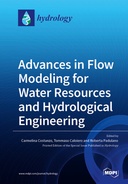Explore

Advances in Flow Modeling for Water Resources and Hydrological Engineering
0 Ungluers have
Faved this Work
Login to Fave
Water resource systems planning and management issues are often very complex. The pressures on water resources are increasing with the expanding scale of global development involving ecological and hydrological consequences in river basins and groundwater aquifers, and water-quality deterioration. All this leads to the increasing need for investigating the effects of different human influences and impacts on the hydrological regime and on water quality like as land-use changes, climatic variability and climate changes, and intensified water and land-use practices. The Special Issue “Advances in Flow Modeling for Water Resources and Hydrological Engineering” presents a collection of scientific contributions that provides a sample of the state-of-the-art and forefront research in this field. In particular, basin-wide water resources planning, watershed management, flood forecasting, droughts, climate change impacts on flood risk and water resources, reservoir operation and management, river morphology and sediment transport, river water quality, and irrigation were the main research and practice targets that the papers published in this Special Issue aimed to address.
This book is included in DOAB.
Why read this book? Have your say.
You must be logged in to comment.
Rights Information
Are you the author or publisher of this work? If so, you can claim it as yours by registering as an Unglue.it rights holder.Downloads
This work has been downloaded 96 times via unglue.it ebook links.
- 96 - pdf (CC BY) at Unglue.it.
Keywords
- abrupt negative step
- Australia
- bed forms
- best streamflow prediction
- boundary layer characteristics
- Boussinesq equations
- burned areas
- CFD
- Climate Change
- climate-change impacts
- croatia
- dam break
- direct rainfall modelling
- DRAINMOD
- drought
- dry and wet beds modeling
- eddy viscosity
- energy loss
- energy slope
- Ethiopia
- evapotranspiration
- field-scale hydrological models
- flat chute
- flocculation
- Flood
- flood forecast
- flow resistance
- geological categories
- gravel bed rivers
- headwater catchments
- History of engineering & technology
- hydraulic jump
- hydrologic processing strategies or hypotheses
- hydrological modeling
- hydrological modelling
- hydrology
- infiltration capacity
- inverse probability weighting
- inverse variance weighting
- Iowa
- log law
- log wake
- maximum flow
- maximum precipitation
- Medvednica Mt.
- mixing length
- modified Mann–Kendall trend test
- MODIS
- momentum closure
- multi models
- multi-variable calibration
- near-natural catchment
- nitrate leaching
- nonlinear model
- numerical model
- Numerical Simulation
- NW Spain
- open channels
- OpenFOAM
- parabolic profile
- Parshall flume
- physical modeling
- plunging
- post-fire
- Probability
- Python
- RANS
- real-time hydrologic forecasting system
- regional flood frequency
- representative concentration pathways 4.5 and 8.5
- reservoir management
- Rift Valley
- river discharge
- river flow
- river morphology
- river quality
- satellite precipitation products
- SCS-CN
- sediment load
- serverless computing approach
- shallow water equations
- shock wave
- skin friction
- specified intervals
- spillway
- spillway pier
- SR2MR streamflow forecasting
- Stream discharge
- Streamflow
- streamwise velocity distribution
- subsurface flow
- SWAT
- Technology, engineering, agriculture
- Technology: general issues
- Thornthwaite–Mather method
- tile drainage
- tiling
- Trend Analysis
- turbulence model
- turbulent kinetic energy (TKE)
- underflow
- ungauged catchments
- variational ensemble forecasting
- venturi flume
- Water
- Water balance
- water resources modelling
- watershed hydrology
- Watershed management
- Yukon River plume
- Ziway Lake Basin
Links
DOI: 10.3390/books978-3-0365-6511-8Editions

